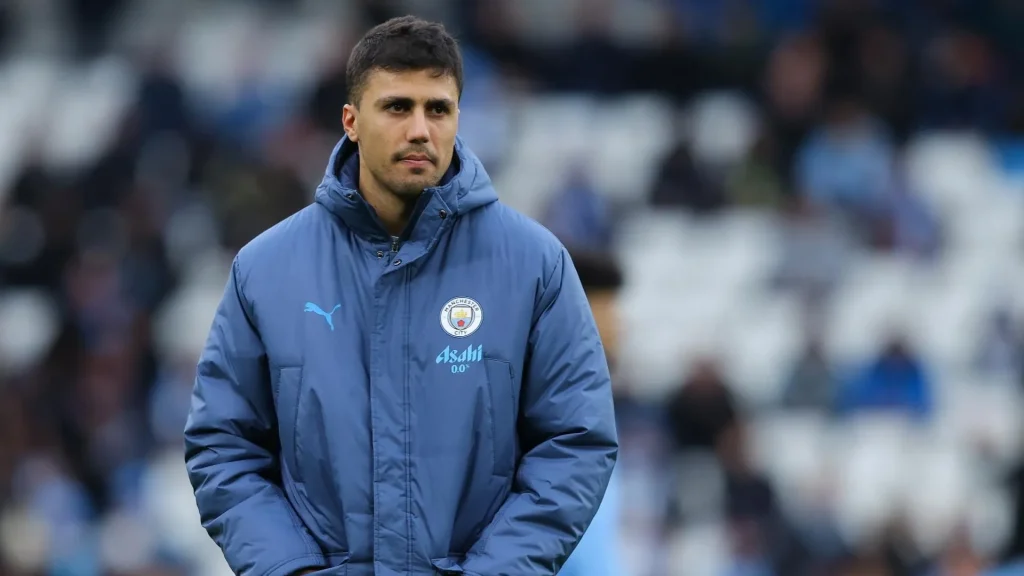
Premier League Power Rankings: Final 2024–25 Update as the Season Closes
Back in August, it felt ambitious to rank Nottingham Forest as high as 14th. By September, Brighton and Tottenham were climbing, and we convinced ourselves one of them was a top-five lock. In November, Spurs were still flying, and—perhaps most embarrassingly—we thought Manchester United were comfortably midtable. (Silly us.) Come January, the AFC Bournemouth hype train was in full motion.
Such is the life of tracking Premier League power rankings across a long, chaotic season. Perception swings wildly, heroes rise and fall, and somehow, we’ve arrived at the final days of the 2024–25 campaign with Newcastle United and Aston Villa on fire, Manchester City cemented in fourth like a laminated pub quiz answer, and Nottingham Forest drifting back toward familiar territory.
Postseason playoffs, anyone? No? Just us?
Anyway, here’s our final 2024–25 Premier League power rankings, combining the individual lists of Bill Connelly and Ryan O’Hanlon. We include January’s rankings for context, alongside current points and goal differential as of mid-May:
🔝 Final 2024–25 Premier League Power Rankings
| Rank | Team | January Rank | Points | Goal Difference |
|---|---|---|---|---|
| 1 | Newcastle United | 5 | 69 | +27 |
| 2 | Aston Villa | 7 | 67 | +22 |
| 3 | Arsenal | 2 | 75 | +39 |
| 4 | Manchester City | 4 | 74 | +34 |
| 5 | Liverpool | 3 | 73 | +30 |
| 6 | Tottenham Hotspur | 6 | 62 | +12 |
| 7 | Chelsea | 9 | 59 | +10 |
| 8 | Brighton | 8 | 54 | +6 |
| 9 | Manchester United | 10 | 49 | -3 |
| 10 | Bournemouth | 11 | 47 | -4 |
| 11 | West Ham | 12 | 45 | -7 |
| 12 | Wolves | 13 | 43 | -8 |
| 13 | Crystal Palace | 15 | 41 | -5 |
| 14 | Brentford | 14 | 40 | -6 |
| 15 | Fulham | 16 | 38 | -10 |
| 16 | Nottingham Forest | 14 | 35 | -15 |
| 17 | Everton | 17 | 34 | -13 |
| 18 | Luton Town | 18 | 30 | -21 |
| 19 | Burnley | 19 | 28 | -23 |
| 20 | Sheffield United | 20 | 24 | -35 |
📉 Notable Trends & Takeaways
- Newcastle and Aston Villa surge: Their late-season form was undeniable, with both clubs turning solid campaigns into exceptional ones. Villa in particular have made Champions League qualification feel earned, not gifted.
- City’s solid fourth: No title this time, but Guardiola’s men remained consistently strong, despite a few midseason dips.
- Forest’s fade: Their early-season overperformance gave way to a reality-check second half. By May, 14th had turned out to be optimistic after all.
- United’s mediocrity: The Red Devils avoided complete collapse, but only just. Their season ends with more questions than answers—and more losses than fans care to count.
- Chelsea’s quiet climb: Up from 9th to 7th, they’ve closed strong, if unconvincingly. Maresca’s system may yet bloom.
- Bournemouth’s reality check: January’s darlings hit a ceiling, but progress under Andoni Iraola remains real.
Power rankings may be fickle, but they capture what the table doesn’t: form, narrative, and the wild, shifting momentum of a 38-game marathon. The 2024–25 season gave us more than a few twists — and the real winners were the fans who managed to keep up.
Better Late Than Never: Newcastle and Villa’s Scorching Finish
Imagine, just for a moment, that the Premier League adopted a season-ending playoff format like Belgium’s Pro League — where the top six teams, after a full round-robin season, have their point totals halved and play a final mini-league to crown a champion. It’s chaotic, it’s unorthodox… and it’s kind of fun in theory.
Yes, the math is awkward for a 20-team league (38 games followed by 10 more), but let’s suspend reality and run with it.
Using analyst Simon Tinsley’s full-season projections — halving point totals and rounding up — our hypothetical Premier League playoff would begin like this:
- Liverpool: 44 points
- Arsenal: 37
- Manchester City: 35
- Newcastle: 35
- Chelsea: 33
- Aston Villa: 33
Liverpool would still be heavy favorites, but the real intrigue lies in the red-hot form of Newcastle and Aston Villa, who would be serious threats in a playoff sprint.
Since March 8, Villa (2.63) and Newcastle (2.44) are the only two teams averaging over 2.0 points per game in the league — and they’re not doing it with smoke and mirrors. Their underlying numbers back it up. No major overperformance, just sustained, high-level football.
Villa have lost just three of their past 15 games. Newcastle? Just one loss in their last 10 — and that was to Villa.
In any alternate universe where post-season playoffs decide the Premier League title, Newcastle and Villa would be surging into the top three conversation. Even in this universe, their late-season runs have turned heads — and may shape the next one.

Newcastle & Villa: Peaking at the Perfect Time
Since March 8, no Premier League teams have surged harder — or smarter — than Newcastle United and Aston Villa. Their profiles are almost mirror images: Newcastle boast the league’s best attack and third-best defense in this span, while Villa flip that equation with third-best attacking numbers and the tightest defense in the league. Unsurprisingly, both teams have leapt up our power rankings.
⚫ Newcastle: Ruthless, Direct, and Reborn
Newcastle’s resurgence has been powered by a lethal wing duo: Jacob Murphy on the right and Harvey Barnes on the left. Since March 8, they’ve combined for 7 goals and 7 assists, a staggering return for wide players in a counter-heavy setup.
Barnes, in particular, has edged out Anthony Gordon to become the first-choice left winger. He’s already contributed 13 goals + assists in significantly fewer minutes than it took to tally 14 for Leicester City last season — almost 1,100 fewer, to be exact. Add in 74 progressive carries during this run — second-most at Newcastle and fifth among non-defenders in the league — and Barnes has become the perfect foil to Alexander Isak’s central brilliance. Newcastle are surging while others fade.
🟣 Villa: Relentless Discipline, Ruthless Finishers
Aston Villa, meanwhile, have built a fortress. Their recent run features only 41.4% possession (16th in the league) and just 29.3 attacking-third touches per game (18th), yet they’re not just surviving — they’re thriving.
Villa have allowed opponents to take shots (17th in shots allowed per possession), but not from dangerous areas: their 0.11 xG allowed per shot is the best in the league. They’re compact, disciplined, and efficient.
And when they do strike? They do it late and lethal. Since March 8, Villa lead the league with 7 goals after the 70th minute, while conceding just one. The January arrivals of Marcus Rashford (loan) and Donyell Malen (€23m) have given Unai Emery crucial rotational depth — Malen, for example, has bagged two of those late goals off the bench.
⏪ From Struggling to Surging
Back on March 8, Villa sat 7th with 45 points, and Newcastle were 8th with 44. Newcastle had just been hammered by Liverpool and City (a combined 6-0), while Villa were in the midst of a five-match winless skid. Since then, they’ve completely flipped the script.
As of now, both clubs are ranked among the top 10 teams in the world, per the Opta supercomputer. Their odds of securing a top-five Premier League finish have skyrocketed:
- Newcastle: 95% (Opta & Tinsley)
- Villa: 37% (Tinsley) to 42% (Opta)
And with both clubs facing Europa League finalists — Tottenham (May 16) and Manchester United (May 25) — in their final two matches, they could capitalize on distracted opponents to seal a late miracle.
Manchester City: Never Hit Top Gear
For most of the season, we kept waiting for Manchester City to click. Surely they’d start racking up goals, locking down games, and returning to their suffocating best… right?
Not quite.
Now, with just two games remaining, City find themselves just two points (and some goal difference) away from missing the Champions League altogether — something that seemed unthinkable back in January. Sure, they’re likely to survive (Tinsley gives them a 95% chance of a top-five finish), but the margin is slimmer than expected.
What makes this even more jarring is the spending: City invested €218 million on five players in January — no other club in Europe even topped €55m.
And since February? Despite the influx of talent, City’s adjusted goal difference (a blend of 70% xG and 30% actual goals) has been flat. They haven’t fallen apart, but they haven’t accelerated, either. In a season where others surged late, City stayed in fourth gear — and it might cost them.
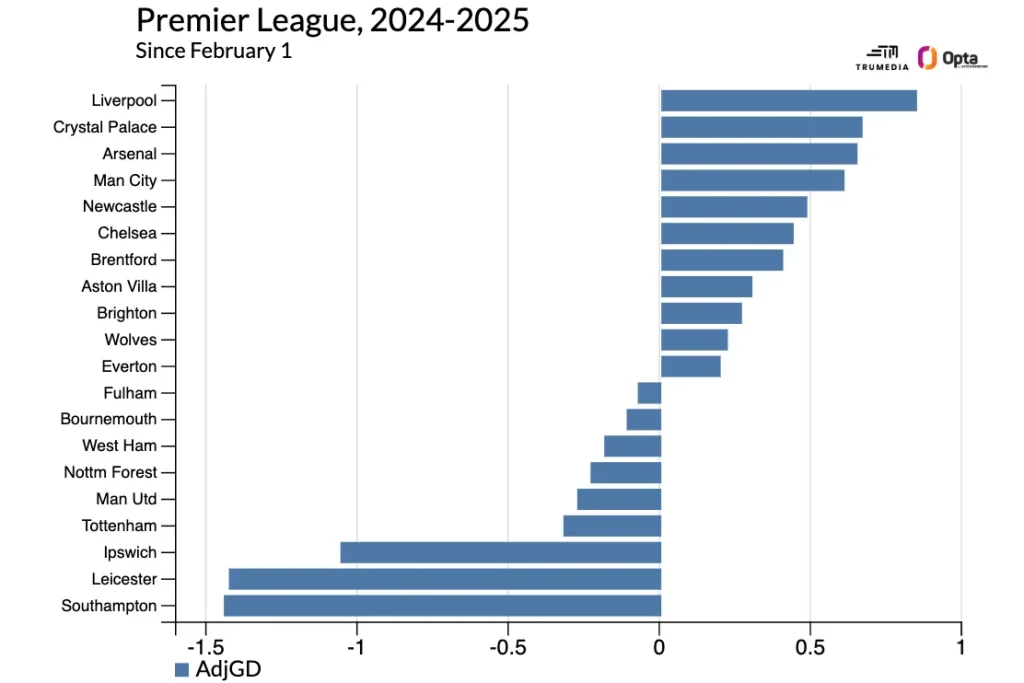
And here’s how things looked before the start of February:
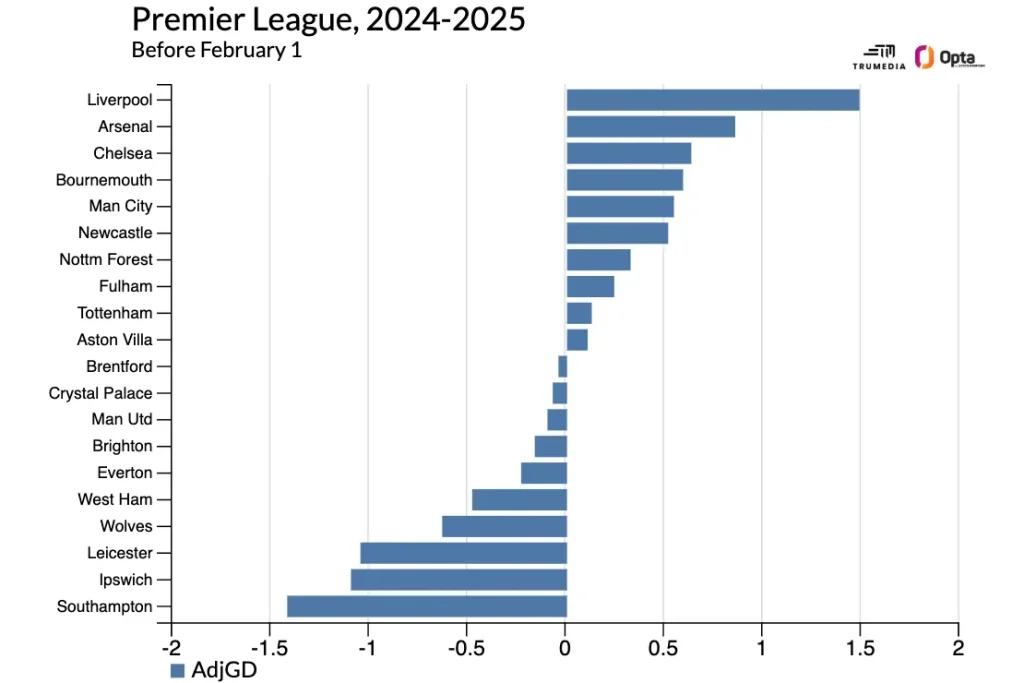
Manchester City: Stability Gained, Spark Lost
There’s been a modest uptick in Manchester City’s performance metrics since February — their adjusted goal difference rose from +0.54 to +0.61, nudging them from the fifth-best team in the league to fourth. But this wasn’t the kind of resurgent push we saw from Liverpool in the late stages of their “down years” under Klopp (2020-21, 2022-23). This was a borderline top-four side becoming… a slightly more secure top-four side. That’s it.
🔐 Defense: Vastly Improved
The biggest shift has been at the back. City’s adjusted goals allowed has plummeted from 1.41 per game pre-February to 0.96 post-window. They’re now giving up nearly five fewer shots per game — down from 13.3 to just 8.0. And though they’re conceding more dangerous shots on average (0.11 xG per shot, up from 0.14), the overall volume drop has massively improved their defensive profile.
City’s press has also grown more effective, thanks largely to the introduction of younger, more energetic legs in midfield and attack. The defensive solidity they lacked early in the season is finally in place.
⚠️ Attack: Regressing Sharply
But that defensive gain has come at a significant attacking cost.
- Adjusted goals scored per game has dropped from 1.96 to 1.57
- Shots per game have fallen from 17.2 (near Liverpool’s 17.7) to just 13.8
- Shot quality has remained stagnant
This isn’t a case of trading quantity for quality — it’s simply less of everything up front.
Last weekend’s game against Southampton summed it up. City faced a side with nothing at stake and, as Rúben Dias bluntly noted, a team that “didn’t even try.” Yet, City labored to create anything meaningful in the final third. They controlled possession, pressed well, kept shape — and offered very little threat.
🔄 Trading One Imbalance for Another
Earlier in the season, City could attack but couldn’t defend. Now, they defend well but can’t create chances. They’ve swapped one imbalance for another.
For a club with Champions League aspirations and a €218m winter spending spree, it’s an underwhelming return. And while they still hold a 95% chance of finishing top five, per projection models, they’ve looked far more like a Europa League side than the dynasty we’ve come to expect.
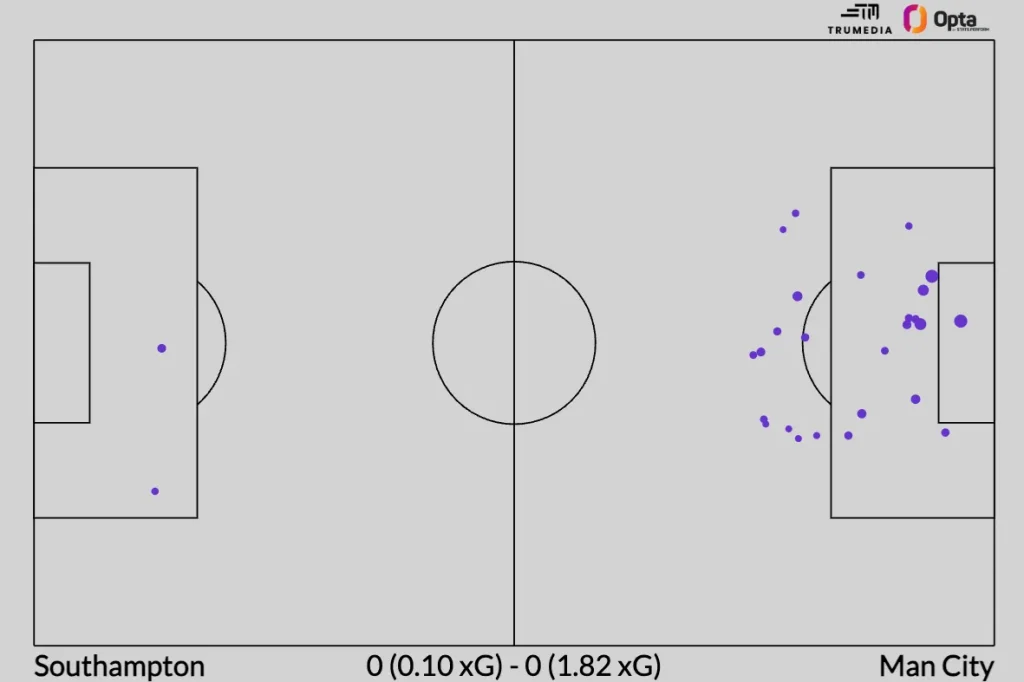
Manchester City: No Longer Field-Tilters
Despite City’s late-season defensive revival, they’re not a sure thing to take maximum points from their final two games — especially against well-organized midtable sides like Fulham and Bournemouth. That’s because this version of City lacks the overwhelming dominance of past years. They no longer tilt the pitch so far in their favor that opponents can barely breathe, let alone counterattack.
They should still sneak into the top five, thanks to a points cushion and goal difference, but the bigger concern is forward-looking:
They aren’t close to title-contending form — not compared to Liverpool or Arsenal, and not by their own high standards.
City must make meaningful tactical and personnel changes this summer if they want to rejoin the title race. As of now, they’re a Champions League-level team on paper, but a Europa-level team in performance.
— O’Hanlon
🌲 Nottingham Forest: The Regression Arrived
Six weeks ago, Forest were flying high — third place, unbeaten in four, and riding back-to-back 1-0 wins over Manchester United and Manchester City. But after Sunday’s 2-2 collapse against relegated Leicester, they’re down to seventh, and Champions League hopes are slipping away fast.
They’ve won just once in their last six league games, and the fall has been less about a collapse and more about reality catching up.
📉 The xG Problem
- On April 1:
- Goals: 50 (6th)
- Expected Goals (xG): 38.0 (15th)
- Goal differential: +15 (4th)
- xG differential: +1.8 (10th)
This was a team outperforming its underlying numbers massively. They won five league games with negative xG differentials, and in nine matches where they were clearly second-best by xG (–0.75 or worse), they still managed eight points.
Now that their finishing luck and defensive resilience have cooled off, so has their league position.
⚽️ Chris Wood: The Super Outlier
- 20 goals on 12.4 xG
- That kind of finishing isn’t sustainable — and once it normalized, so did Forest’s results.
🚨 Summary
Forest’s statistical profile always hinted at overperformance, and their slide isn’t surprising. After narrowly avoiding relegation in recent years, even finishing 7th-9th would be progress — but their once-realistic Champions League dream now looks like a mirage.
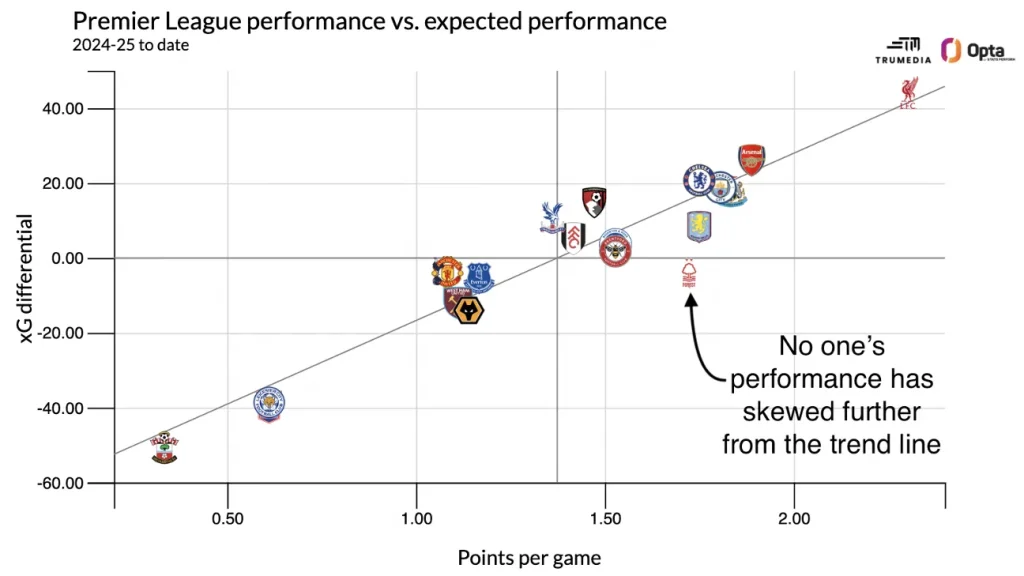
Nottingham Forest: Luck, Meet Limits
Forest aren’t just cooling off — they’ve slammed into the wall. Over their past six matches:
- ❌ Only 1 win
- 📉 0.83 points per game (15th)
- 🔻 –5.6 xG differential (17th)
Despite still squeezing results out of poor performances — like the 2-1 win over Spurs and 1-1 draw vs. Palace — the numbers suggest the overperformance tank is finally running dry.
⚖️ On Paper: Forest ≈ Everton/United
Forest’s true level is likely somewhere near Everton or Manchester United, not Chelsea or Manchester City, and that reality is finally being reflected in results.
But their story isn’t done yet:
- 🆚 This weekend: West Ham (also struggling)
- 🏁 Final match: Chelsea, without Nicolas Jackson (who has a measurable impact on Chelsea’s performance)
Champions League hopes aren’t dead — but Forest have likely used up most of their margin for error.
— Connelly
⚔️ The Midtable Arms Race: Everyone’s Been Good & Awful
From Brentford’s surge to 8th to Palace’s FA Cup final appearance and top-10 adjusted goal difference, the Premier League’s middle class has never been stronger — or more unpredictable.
At some point this season, each of these clubs looked legit:
- Brighton (early-season attacking brilliance)
- Fulham (pressing & structure)
- Wolves (late-season run)
- Everton (Moyes’ defensive solidity)
- Bournemouth (January surge)
- Forest (March peak)
- Palace & Brentford (right now)
This isn’t just anecdotal. According to Club Elo Ratings (pure results-based), the Premier League has:
🏆 17 of the 50 best clubs in the world:
- ⚡️ Villa: 11th
- 🦅 Palace: 16th
- 🐝 Brentford: 17th
- 🍒 Bournemouth: 20th
- 🌲 Forest: 22nd
- 🟡 Brighton: 24th
- 🔴 Man United: 25th
- 🐔 Tottenham: 31st
- ⚫️ Everton: 33rd
- ⚪️ Fulham: 34th
- ⚒️ West Ham: 41st
- 🐺 Wolves: 44th
- 🔥 Burnley: 47th
- 🦚 Leeds: 49th
If club strength were evenly distributed across the five top European leagues, you’d expect ~8–9 teams per league in the top 50. The Premier League has 17 and will likely have 19 next season.
The top of the Premier League table might look shakier this year, but the bottom and middle have never been stronger — and that’s made every match tougher for everyone.
— O’Hanlon
🔮 Takeaway
This season wasn’t about a traditional “Big Six” narrative or a dramatic final-week title decider. It was about the emergence of a terrifyingly strong middle tier — one that has made life miserable for top clubs and erased the idea of “easy wins.”
Expect even more chaos next year.
Leave a Reply